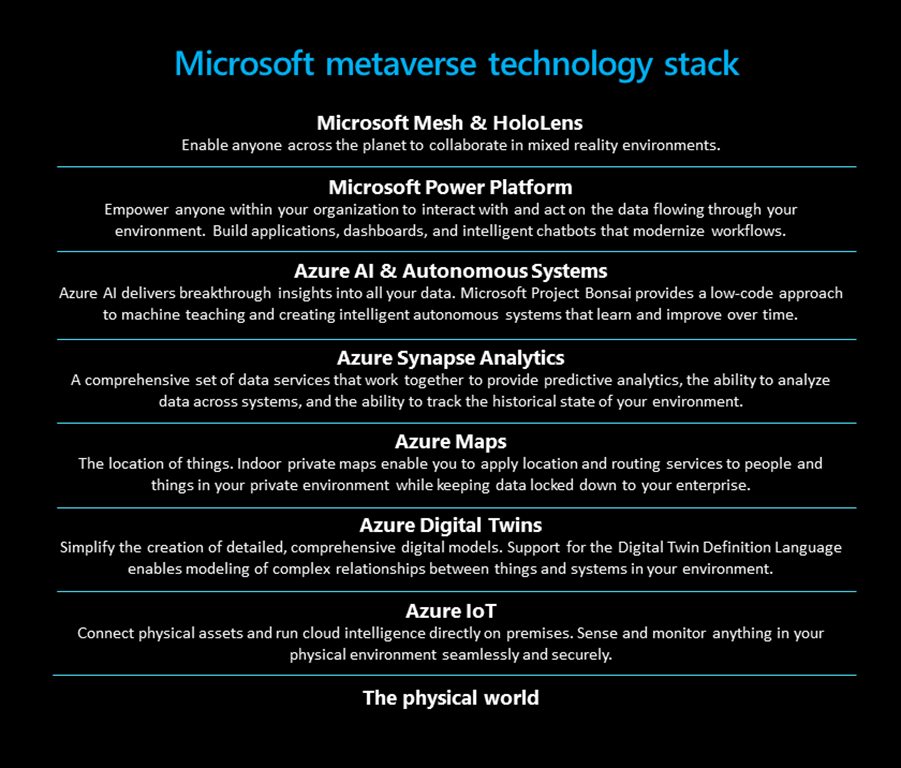26
May

Cloud and edge computing are coming together as never before, leading to huge opportunities for developers and organizations around the world. Digital twins, mixed reality, and autonomous systems are at the core of a massive wave of innovation from which our customers already benefit.
From the outside, it’s not always apparent how this technology converges or the benefits that can be harnessed by bringing these capabilities together. This is why at Microsoft Build we talk about the possibilities this convergence creates, how customers are already benefitting, and our journey to making this technology easier to use and within reach of every developer and organization.
The possibilities of connected environments
Imagine taking any complex environment and applying the power of technology to create awe-inspiring experiences and reach new business heights that were previously unimaginable. The possibilities are endless: A retail store where the shopping experience is optimized in real-time and shelves are always stocked. A supply chain that tracks and reduces carbon emissions. A process manufacturing line that adjusts for variations in natural ingredients and automatically detects and compensates for operational bottlenecks. A city plan that simulates various growth proposals to ensure they’re making the best use of energy sources.
26
May

“Tech companies born with an open-source mentality get it. It’s our ability to work together that makes our dreams believable, and ultimately achievable; we must learn to build on the ideas of others”—Satya Nadella, CEO, Microsoft
Microsoft has always been a developer-first organization, and we are striving to make our tools and platforms better to serve developers. In that spirit, Azure is designed to give developers control over their infrastructure and provide the greatest flexibility regardless of operating system, database, language, deployment tool, or methodology, and to extend those options on-premises and to the edge. Today, many of those systems are open source: Linux, Kubernetes, Spark, and Python—just some of the best-known examples. And so Azure has been built to run those technologies, either at the infrastructure as a service (IaaS) or platform as a service (PaaS) levels, through Linux running in virtual machines (VMs), or our Azure Kubernetes Service (AKS) for cloud-native development, often in tandem with one of our managed services for popular open-source databases.
We are committed to open source at Microsoft. We contribute to Linux, Kubernetes, Visual Studio Code, and serving in open-source organizations like the Cloud Native Computing Foundation (CNCF) or Open Source Security Foundation (OpenSSF). At
25
May

The global population of developers is estimated to reach 71.5 million in 2030, an increase of 44.5 million developers from today1. Each new developer brings their ideas and innovations that they’d like to share with the world. It is our mission to empower this next generation of developers with world-class tools and cloud services that allow them to build the applications of the future.
These applications of the future will be intelligent, infused with AI to provide advanced insights. They will incorporate open-source technology and libraries from across the globe. They will be reliable under load and secure by design. And they will be built with tools that allow developers to move from idea to code to cloud, seamlessly.
We see customers on Microsoft Azure building these applications of the future today, by leveraging cloud-native technologies like containers, Kubernetes, microservices, serverless functions, and API-centric designs.
Mercedes Benz is improving the in-vehicle experience for their customers by delivering applications dynamically over the air, instead of requiring an in-person maintenance visit. PwC is helping ensure their clients are compliant with regulations using an AI-powered system that can mine and analyze documents in seconds instead of weeks. Bosch
25
May

Java is one of the most popular programming languages, used by over seven million developers to create everything from enterprise applications to complex robots. Over the past several years we’ve seen an evolution in the Java ecosystem, with the accelerated growth of open-source tools and frameworks like Spring. Microservice architectures are becoming more prevalent, and developers are building more applications on cloud platforms using containers and managed services. The Java ecosystem is complex and running Java applications in the cloud at an enterprise scale can be challenging. Our customers are asking us to help them modernize their Java applications and run them on an enterprise-grade platform—Azure.
We’ve made substantial investments in Java to support a wide range of customer workloads, from the development of Azure Spring Cloud with VMware as a managed destination for Spring Boot applications to the acquisition of jClarity, and the creation of our Microsoft Java Engineering Group. The Microsoft Build of OpenJDK provides a new supported Java runtime option on Azure with the potential for Azure-tuned optimizations—now generally available. We now support the full range of Java EE and Jakarta EE application servers through collaborations with Red Hat, Oracle, and IBM, with newly released offers